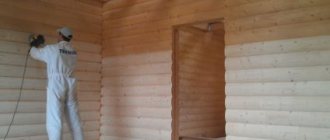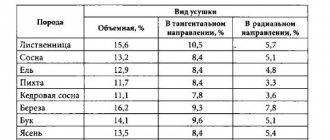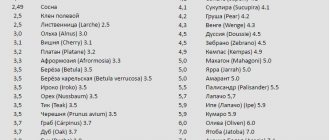Cut-to-length blanks using a saw and forwarder
When using a chainsaw to fell a tree, extreme care must be taken. When sawing logs, you need to try to ensure that the processed assortments meet all production standards. The processed log is laid out in staples along the route of the forwarder, which speeds up its work.
When cutting cut pieces, the chainsaw plays a major role in the work process. The tool should be light in weight, this makes the saw easy to operate. It is important that the saw meets the safety characteristics of the worker and does not have a harmful effect on his future well-being. The chainsaw must be maintained daily in accordance with technological requirements, which will increase the efficiency and safety of its operation, as well as increase its service life. A tree feller's equipment includes a helmet with a protective visor, thick earmuffs, work gloves and comfortable shoes.
For the safety and efficiency of cut-to-length procurement work, planning of work activities is necessary. You also need preliminary planning and marking of belt trails.
Upon completion of logging, the processed logs and the materials obtained from them are stored in piles, sorted according to assortment parameters and placed in the operating area of a hydraulic manipulator crane installed on the forwarder. It is recommended to leave a large amount of wood debris at the harvesting site during work, this protects the soil layer.
Profitability of cut-to-length billets
Today, with modern machine technologies, the effectiveness of cut-to-length billets depends on their correct use. An important role in this is played by the professionalism of the entire working team - from the forwarder driver to the site manager. Everyone is required to constantly improve their working qualifications and undergo appropriate training. A thoughtful layout of each work area is the basis for successful work. Timely decisions on the distribution of a site and the establishment of its boundaries make it possible to improve the work process, and a clear distribution of routes for wheeled vehicles can reduce the damage caused to nature to a negligible minimum.
The main main routes must be subject to constant inspections, mobile repairs and, as they wear out, undergo complete modernization. Planning work must be carried out in full accordance with area maps and written instructions. In ideal cases, logging workers themselves carry out the planning of the site, based on its topography and taking into account the technological features of wheeled vehicles and the availability of the necessary timber.
Further work on tree demolition takes place according to a pre-planned plan. From now on, the success of the work performed depends on each of its participants and the overall teamwork of the entire team. General meetings are encouraged, at which work issues and the exchange of production experience should be discussed.
A system of logging operations with primary processing of the material directly on site, the presence of competent working personnel and a specific plan for the work carried out are the key to a significant reduction in production costs. A critical factor influencing the profitability of cut-to-length logging is the correctly selected site for logging operations, which has the material that meets the needs of sawmills. To increase the profitability of cut-to-length billets, you need to tirelessly monitor the quality indicators of manufactured products and improve production efficiency.
Cut-to-length timber harvesting is a very important job, providing high-quality material to many industrial enterprises, whose products significantly improve our lives.
Methodology of cut-to-length billets
When carrying out cut-to-length work, fellers need to remember two important conditions:
- Ensuring easy alignment of the processed assortment.
- The work must be planned so that the processing of trunks is carried out at a comfortable height.
The first is ensured by felling the tree towards the processing station. The second involves the transverse felling of a tree onto a prepared staple, or a stone pile or stump.
To increase the efficiency of logging operations, tree felling is carried out in such a way that the trunk falls at a strictly calculated point. To facilitate a controlled fall in the required direction, it is recommended that the frame be cut at a right angle to the place where the trunk falls. A tree a couple of centimeters thick is cut down in the direction of the fall, this makes it easier to control the fall. To achieve jewelry precision, wedges and special levers are used.
In the process of removing branches, the feller needs to hold the chainsaw at a certain angle to the trunk and remove them according to the developed system. The feller must measure the length and thickness of the log, this will help determine what sorts of logs can be obtained from this log. Using the working tool, the cutting point is determined. To continue the work, the feller cuts down all the branches, after which the processed tree trunks are collected in stacks located along the routes of the forwarders.
As a rule, preliminary marking of trees is not carried out. Therefore, having received instructions, the feller needs to determine directly at the cut-to-length logging site which tree is to be cut down and which is not. This allows trees to be cut down selectively and with maximum efficiency.
Transportation of timber by forwarders
Cut-to-length timber harvesting has the advantage that large-sized trucks are not needed to transport wood material directly inside forest areas. Comparatively compact and all-terrain forwarders cope well with its functions. These machines, which transport processed cut-to-length material, play the role of a connecting system link in the procurement of small assortments. The forwarder's all-wheel drive control system allows it to move over difficult terrain. They have increased stability and unique cross-country ability even in cluttered and swampy areas with the presence of various kinds of obstacles, be it a deep hole or a high stump. If you need to minimize the pressure on the soil cover, the tires can be lowered, or larger diameter tires can be used. To further increase the vehicle's all-terrain capability, its wheels are equipped with special chains.
The forwarder is produced on a six- and eight-wheel base. It is equipped with a unique running system, each wheel has an independent hydraulic suspension, this allows you to change the ride height on different working and road surfaces and compensate for slopes. When work is carried out on a steep slope, the load-bearing frame of the forwarder remains in a horizontal position. The ground clearance is adjusted by the operator using a mechanical element that controls hydraulic suspensions, or this is done automatically while the forwarder overcomes any obstacle. Machines with a lifting capacity of over 10 tons are equipped with special gripping mechanisms that allow loading and unloading work to be carried out autonomously.
To increase the efficiency of the forwarder, it is necessary to reduce its empty movements to a minimum. The operation of the machine should begin from the far mark of the working area and, as it moves to the processing point, the forwarder will take the maximum number of assortments. When the driver manages to load a one-size assortment, it becomes possible to immediately go to the loading point. This will help avoid mixing different sized assortments with each other. The forwarder driver must devote more than half of his working time to controlling lifting mechanical grippers, so he must have the skills to pick up logs and the ability to dampen the amplitude of his swinging in the air.
Good planning of work and careful transportation of wood assortments will avoid harmful consequences for the environment. It is clear that wheeled vehicles should move less on surfaces with soft soil, except when it freezes. In addition, it is necessary to prevent damage to nearby trees during loading and unloading operations and during transportation.
Removal of cut-to-length material
Transportation of log materials from forest areas is carried out by log trucks. Their size and designs are regulated by local road regulations. To achieve minimization of costly activities for the production of a unit of finished material and combine this with a reduction in the harmful effects of harmful gas exhausts, it is necessary to load log trucks as much as possible. The length of such road trains can be more than 25 meters, and the load capacity can reach more than 40 tons. Almost all log carriers have a special loading manipulator used for loading both from the ground and from forwarder machines. To ensure maximum loading, the loading mechanism can be easily removed.
General information about cut-to-length timber
Today, no one doubts the fact that the most effective method of freight transportation is wheeled vehicles. Therefore, it became the basis of the technological process of cut-to-length wood blanks. The obviousness of the advantages of such a framework is beyond doubt. We list the main ones:
- Cut-to-length wood, shot using forwarders, remains clean and undamaged, since there is no contact with the road during transportation.
- The wheelbase of modern forwarders has a characteristic that allows minimizing pressure on the soil during logging operations and transportation of wood.
- Large cargo can also be transported on wheeled forwarders, which makes logging work less expensive. In addition, there is no need for the infrastructural development of highways necessary for transporting wood.
- Wheeled vehicles can easily move along ordinary roads, transporting wood to nearby destinations.
- Logging work, that is, processing of a fallen tree, is carried out directly at the felling site using a chainsaw or felling, cross-cutting and delimbing machines. Modern cut-to-length logging has made it possible to minimize the transportation of excess cargo. It should be noted that in order to restore forest funds, we need nutritional components that are contained in the upper parts of the tree.
- If the tree trunk is cut directly at the felling site, it is possible to deliver assortments of some volumes directly to the warehouse.
- Cut-to-length logging has systemic and technological advantages that contribute to the development of industrial wood processing and forest restoration processes. And end consumers cannot even notice the improvement in the products.










